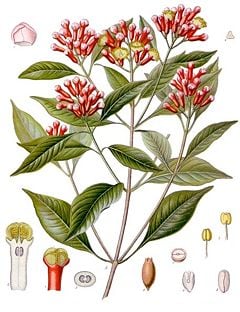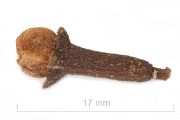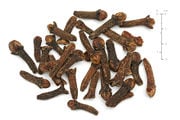Difference between revisions of "Clove" - New World Encyclopedia
Rick Swarts (talk | contribs) (Added most recent Wikipedia version and updated credit/category tags) |
Rick Swarts (talk | contribs) |
||
| Line 15: | Line 15: | ||
}}[[Image:CloveCloseUp.jpg|left|thumb|180px|A single dried clove [[flower]] bud]] | }}[[Image:CloveCloseUp.jpg|left|thumb|180px|A single dried clove [[flower]] bud]] | ||
| − | ''' | + | '''Clove''' is the common name for a small, tropical [[evergreen]] [[tree]], ''Syzygium aromaticum'' ([[synonymy|syn.]] ''Eugenia aromaticum'' or ''Eugenia caryophyllata'') and for the aromatic, dried, unopened [[flower]] buds of this tree, which are used as a [[spice]]. The term also is used simply as the name of the spice, and often in the plural as "cloves." In another sense of the term, clove also can mean one section of a separable bulb, such as a clove of [[garlic]]. |
| + | |||
| + | Cloves are on eof the world's most important, popular, and useful spices, with historical purpose from the beginning of the spice trade. ... culinary, medicinal, perfume, essential oil | ||
| + | |||
| + | and used as a [[spice]] in cuisine all over the world. | ||
| + | |||
| + | ==Description== | ||
| + | The clove tree, ''Syzygium aromaticum'', is in the Myrtle family '''Myrtaceae''', a [[taxon]] of [[dicotyledon]] [[plant]]s, placed within the order [[Myrtales]]. The family [[Myrtaceae]] has at least 3000 species distributed in 130-150 genera, including such well-known representatives as [[myrtle]], [[guava]], [[feijoa]], [[allspice]], and [[eucalyptus]]. All species are woody, with [[essential oil]]s, and have [[flower]] parts in multiples of four or five. The flowers have a base number of five [[petal]]s, though in several genera the petals are minute or absent. The [[stamen]]s are usually very conspicuous, brightly colored and numerous. The [[leaf|leaves]] are [[evergreen]], alternate to mostly opposite, simple, and usually with an entire (not toothed) margin. One notable character of the family is that the [[phloem]] is located on both sides of the [[xylem]], not just outside as in most other plants. | ||
| + | |||
| + | |||
The clove tree is an [[evergreen]] which grows to a height ranging from 10-20 m, having large oval [[leaf|leaves]] and crimson flowers in numerous groups of terminal clusters. The flower buds are at first of a pale color and gradually become green, after which they develop into a bright red, when they are ready for collecting. Cloves are harvested when 1.5-2 cm long, and consist of a long [[calyx (botany)|calyx]], terminating in four spreading [[sepal]]s, and four unopened petals which form a small ball in the centre. | The clove tree is an [[evergreen]] which grows to a height ranging from 10-20 m, having large oval [[leaf|leaves]] and crimson flowers in numerous groups of terminal clusters. The flower buds are at first of a pale color and gradually become green, after which they develop into a bright red, when they are ready for collecting. Cloves are harvested when 1.5-2 cm long, and consist of a long [[calyx (botany)|calyx]], terminating in four spreading [[sepal]]s, and four unopened petals which form a small ball in the centre. | ||
| + | |||
| + | |||
| + | |||
| + | . Cloves are native to [[Indonesia]] The name derives from French ''clou'', a nail, as the buds vaguely resemble small irregular nails in shape. Cloves are harvested primarily in [[Zanzibar]], [[Indonesia]] and [[Madagascar]]; it is also grown in [[Pakistan]], [[India]], and [[Sri Lanka]]. | ||
== Uses == | == Uses == | ||
| Line 77: | Line 90: | ||
| − | {{Credit|201338874}} | + | {{Credit|Clove|201338874|Myrtaceae|196796696}} |
Revision as of 17:57, 6 April 2008
| Clove | ||||||||||||||
|---|---|---|---|---|---|---|---|---|---|---|---|---|---|---|
 | ||||||||||||||
| Scientific classification | ||||||||||||||
| ||||||||||||||
| Syzygium aromaticum (L.) Merrill & Perry |

Clove is the common name for a small, tropical evergreen tree, Syzygium aromaticum (syn. Eugenia aromaticum or Eugenia caryophyllata) and for the aromatic, dried, unopened flower buds of this tree, which are used as a spice. The term also is used simply as the name of the spice, and often in the plural as "cloves." In another sense of the term, clove also can mean one section of a separable bulb, such as a clove of garlic.
Cloves are on eof the world's most important, popular, and useful spices, with historical purpose from the beginning of the spice trade. ... culinary, medicinal, perfume, essential oil
and used as a spice in cuisine all over the world.
Description
The clove tree, Syzygium aromaticum, is in the Myrtle family Myrtaceae, a taxon of dicotyledon plants, placed within the order Myrtales. The family Myrtaceae has at least 3000 species distributed in 130-150 genera, including such well-known representatives as myrtle, guava, feijoa, allspice, and eucalyptus. All species are woody, with essential oils, and have flower parts in multiples of four or five. The flowers have a base number of five petals, though in several genera the petals are minute or absent. The stamens are usually very conspicuous, brightly colored and numerous. The leaves are evergreen, alternate to mostly opposite, simple, and usually with an entire (not toothed) margin. One notable character of the family is that the phloem is located on both sides of the xylem, not just outside as in most other plants.
The clove tree is an evergreen which grows to a height ranging from 10-20 m, having large oval leaves and crimson flowers in numerous groups of terminal clusters. The flower buds are at first of a pale color and gradually become green, after which they develop into a bright red, when they are ready for collecting. Cloves are harvested when 1.5-2 cm long, and consist of a long calyx, terminating in four spreading sepals, and four unopened petals which form a small ball in the centre.
. Cloves are native to Indonesia The name derives from French clou, a nail, as the buds vaguely resemble small irregular nails in shape. Cloves are harvested primarily in Zanzibar, Indonesia and Madagascar; it is also grown in Pakistan, India, and Sri Lanka.
Uses
According to FAO, Indonesia produced almost 80% of the world's clove output in 2005 followed at a distance by Madagascar and Tanzania.
Cloves can be used in cooking either whole or in a ground form, but as they are extremely strong, they are used sparingly. The spice is used throughout Europe and Asia and is smoked in a type of cigarettes locally known as kretek in Indonesia. Cloves are also an important incense material in Chinese and Japanese culture.
Cloves have historically been used in Indian cuisine (both North Indian and South Indian) as well as in Mexican cuisine, where it is often paired together with cumin and canela (cinnamon).[1] In the north Indian cuisine, it is used in almost every sauce or side dish made, mostly ground up along with other spices. They are also a key ingredient in tea along with green cardamoms. In the south Indian cuisine, it finds extensive use in the biryani dish (similar to the pilaf, but with the addition of local spice taste), and is normally added whole to enhance the presentation and flavor of the rice.
Medicinal uses
Cloves are used in Ayurveda called Lavang in India, Chinese medicine (Ravi & Jagdish) and western herbalism and dentistry where the essential oil is used as an anodyne (painkiller) for dental emergencies. Cloves are used as a carminative, to increase hydrochloric acid in the stomach and to improve peristalsis. Cloves are also said to be a natural antihelmintic.[2] The essential oil is used in aromatherapy when stimulation and warming is needed, especially for digestive problems. Topical application over the stomach or abdomen will warm the digestive tract.
In Chinese medicine cloves or ding xiang are considered acrid, warm and aromatic, entering the kidney, spleen and stomach meridians, and are notable in their ability to warm the middle, direct stomach qi downward, to treat hiccough and to fortify the kidney yang.[3] Because the herb is so warming it is contraindicated in any persons with fire symptoms and according to classical sources should not be used for anything except cold from yang deficiency. As such it is used in formulas for impotence or clear vaginal discharge from yang deficiency, for morning sickness together with ginseng and patchouli, or for vomiting and diarrhea due to spleen and stomach coldness.[4] This would translate to hypochlorhydria.
Ayurvedic herbalist K.P. Khalsa, RH (AHG), uses cloves internally as a tea and topically as an oil for hypotonic muscles, including for multiple sclerosis. This is also found in Tibetan medicine.[5] Ayurvedic herbalist Alan Tilotson, RH (AHG) suggests avoiding more than occasional use of cloves internally in the presence of pitta inflammation such as is found in acute flares of autoimmune diseases.[6]
In West Africa, the Yorubas use cloves infused in water as a treatment for stomach upsets, vomitting and diarrhoea.The infusion is called Ogun Jedi-jedi.
Toxicity
Large amounts should be avoided in pregnancy. [citation needed] Cloves can be irritating to the gastrointestinal tract, and should be avoided by people with gastric ulcers, colitis, or irritable bowel syndrome. In overdoses, cloves can cause vomiting, nausea, diarrhea, and upper gastrointestinal hemorrhage. [citation needed] Severe cases can lead to changes in liver function, dyspnea, loss of consciousness, hallucination, and even death.[7] The internal use of the essential oil should be restricted to 3 drops per day for an adult as excessive use can cause severe kidney damage. [citation needed]
History
Until modern times, cloves grew only on a few islands in the Maluku Islands (historically called the Spice Islands), including Bacan, Makian, Moti, Ternate, and Tidore.[8] Nevertheless, they found their way west to the Middle East and Europe well before the first century CE. Archeologists found cloves within a ceramic vessel in Syria along with evidence dating the find to within a few years of 1721 B.C.E.[8]
Cloves, along with nutmeg and pepper, were highly prized in Roman times, and Pliny the Elder once famously complained that "there is no year in which India does not drain the Roman Empire of fifty million sesterces". Cloves were traded by Arabs during the Middle Ages in the profitable Indian Ocean trade. In the late fifteenth century, Portugal took over the Indian Ocean trade, including cloves, due to the Treaty of Tordesillas with Spain and a separate treaty with the sultan of Ternate. The Portuguese brought large quantities of cloves to Europe, mainly from the Maluku Islands. Clove was then one of the most valuable spices, a kg costing around 7 g of gold[citation needed].
The trade later became dominated by the Dutch in the seventeenth century. With great difficulty the French succeeded in introducing the clove tree into Mauritius in the year 1770; subsequently their cultivation was introduced into Guiana, Brazil, most of the West Indies, and Zanzibar, where the majority of cloves are grown today.
In Britain in the seventeenth and eighteenth centuries, cloves were worth at least their weight in gold, due to the high price of importing them.[citation needed]
The clove has become a commercial 'success', with products including clove drops being released and enjoyed by die-hard clove fans.
Active compounds
The compound responsible for the cloves' aroma is eugenol. It is the main component in the essential oil extracted from cloves, comprising 72-90%. Eugenol has pronounced antiseptic and anaesthetic properties. Other important constituents include essential oils acetyl eugenol, beta-caryophylline and vanillin; crategolic acid; tannins, gallotannic acid, methyl salicylate (painkiller); the flavanoids eugenin, kaempferol, rhamnetin, and eugenitin; triterpenoids like oleanolic acid, stigmasterol and campesterol; and several sesquiterpenes.[9]
Notes and references
- ↑ Dorenburg, Andrew and Page, Karen. "The New American Chef: Cooking with the Best Flavors and Techniques from Around the World", John Wiley and Sons Inc., ©2003.
- ↑ Balch, Phyllis and Balch, James. Prescription for Nutritional Healing, 3rd ed., Avery Publishing, ©2000, pg. 94.
- ↑ Chinese Herbal Medicine: Materia Medica, Third Edition by Dan Bensky, Steven Clavey, Erich Stoger, and Andrew Gamble 2004
- ↑ Chinese Herbal Medicine: Materia Medica, Third Edition by Dan Bensky, Steven Clavey, Erich Stoger, and Andrew Gamble 2004
- ↑ TibetMed - Question: Multiple Sclerosis
- ↑ http://oneearthherbs.squarespace.com/diseases/special-diets-for-illness.html Tilotson, Alan. Special Diets for Illness
- ↑ Chinese Herbal Medicine: Materia Medica, Third Edition by Dan Bensky, Steven Clavey, Erich Stoger, and Andrew Gamble 2004
- ↑ 8.0 8.1 Turner, Jack (2004). Spice: The History of a Temptation. Vintage Books, p. xv. ISBN 0-375-70705-0.
- ↑ Chinese Herbal Medicine: Materia Medica, Third Edition by Dan Bensky, Steven Clavey, Erich Stoger, and Andrew Gamble. 2004
| Herbs and spices | |
|---|---|
| Herbs | Angelica • Basil • Basil, holy • Basil, Thai • Bay leaf • Boldo • Borage • Cannabis • Chervil • Chives • Coriander leaf (cilantro) • Curry leaf • Dill • Epazote • Eryngium foetidum (long coriander) • Hoja santa • Houttuynia cordata (giấp cá) • Hyssop • Lavender • Lemon balm • Lemon grass • Lemon verbena • Limnophila aromatica (rice paddy herb) • Lovage • Marjoram • Mint • Mitsuba • Oregano • Parsley • Perilla (shiso) • Rosemary • Rue • Sage • Savory • Sorrel • Stevia • Tarragon • Thyme • Vietnamese coriander (rau răm) • Woodruff |
| Spices | African pepper • Ajwain (bishop's weed) • Aleppo pepper • Allspice • Amchur (mango powder) • Anise • Aromatic ginger • Asafoetida • Camphor • Caraway • Cardamom • Cardamom, black • Cassia • Cayenne pepper • Celery seed • Chili • Cinnamon • Clove • Coriander seed • Cubeb • Cumin • Cumin, black • Dill seed • Fennel • Fenugreek • Fingerroot (krachai) • Galangal, greater • Galangal, lesser • Garlic • Ginger • Grains of Paradise • Horseradish • Juniper berry • Liquorice • Mace • Mahlab • Malabathrum (tejpat) • Mustard, black • Mustard, brown • Mustard, white • Nasturtium • Nigella (kalonji) • Nutmeg • Paprika • Pepper, black • Pepper, green • Pepper, long • Pepper, pink, Brazilian • Pepper, pink, Peruvian • Pepper, white • Pomegranate seed (anardana) • Poppy seed • Saffron • Sarsaparilla • Sassafras • Sesame • Sichuan pepper (huājiāo, sansho) • Star anise • Sumac • Tasmanian pepper • Tamarind • Turmeric • Wasabi • Zedoary |
Credits
New World Encyclopedia writers and editors rewrote and completed the Wikipedia article in accordance with New World Encyclopedia standards. This article abides by terms of the Creative Commons CC-by-sa 3.0 License (CC-by-sa), which may be used and disseminated with proper attribution. Credit is due under the terms of this license that can reference both the New World Encyclopedia contributors and the selfless volunteer contributors of the Wikimedia Foundation. To cite this article click here for a list of acceptable citing formats.The history of earlier contributions by wikipedians is accessible to researchers here:
The history of this article since it was imported to New World Encyclopedia:
Note: Some restrictions may apply to use of individual images which are separately licensed.


